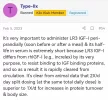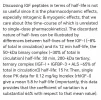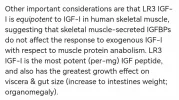Stealth500
Member
Wanted to start an open discussion about the best options for female peptide protocols. Some women here compete and some men have wives and girlfriends who compete.
As we know, women competing in bodybuilding face the risk of virilization when using anabolic steroids. As an alternative to mitigate these potential adverse effects, peptides are a tool that can be utilized.
A significant number of male bodybuilders, myself included, utilize recombinant human growth hormone (rhGH) daily. However, research indicates that women tend to be less responsive to rhGH.
Studies show that when women receive nearly double the dosage of rhGH compared to men, they do not achieve equivalent responses in terms of IGF-I levels, body composition, and bone density. This suggests that simply increasing the dosage for women may not yield the same benefits observed in men. The differences in response may be attributed to hormonal variations and individual physiology, indicating that women may not experience the same advantages from GH therapy, even at higher doses.
For premenopausal women using growth hormone (GH) secretagogues may make sense for some women due to their naturally higher endogenous GH levels compared to men, as these secretagogues aim to stimulate the body's own production of GH.
HGH peptides stimulate the pituitary gland to enhance natural (endogenous) growth hormone production. These peptides act as biological messengers, improving various bodily processes, including cell growth and tissue repair. Growth Hormone-Releasing Peptides (GHRP) and Growth Hormone-Releasing Hormone (GHRH) are classified as secretagogues because they promote the secretion of growth hormone from the pituitary gland. GHRP targets the ghrelin receptor, while GHRH interacts with its specific receptor to facilitate GH release.
For women in bodybuilding, the use of fat-burning agents such as clenbuterol can lead to negative cardiovascular effects, particularly with long-term or repeated abuse.
With the increasing availability of various GLP-1 receptor agonists to combine with secretagogues, new options are available to reduce hunger and body fat by allowing easier adherence to a strict diet.
Adherence to a strict diet can lead to an increase in cortisol levels, which may contribute to a less lean appearance. Elevated cortisol can affect metabolism and fat distribution as a response to low energy availability. This response is part of the body's mechanism to maintain blood glucose levels and manage stress.
Retatrutide primarily mimics gut hormones to regulate blood sugar and appetite, while growth hormone secretagogues (GHS) stimulate the release of growth hormone. The concurrent use of both may not necessarily negate each other's effects, but their combined impact on metabolism and appetite regulation could differ.
Given the wealth of information available, and the amount of misinformation online. I would like to leverage our collective knowledge to address the following questions for the benefit of female competitors:
What secretagogue and GLP-1 protocols will yield the most significant improvements in lean muscle mass for women while mitigating potential negative side effects?
How can we optimize meal timing and training schedules to maximize the effectiveness of these dosing protocols?
For instance, tesamorelin and ipamorelin can work synergistically to enhance growth hormone stimulation, potentially leading to improved metabolic effects and reduced side effects compared to traditional growth hormone therapies. Their combined use may result in more sustained and controlled growth hormone release. Additionally, retatrutide may help counteract hunger signals that could be influenced by tesamorelin and ipamorelin.
Understanding that meal timing is crucial when using secretagogues as opposed to rhGH, I propose the following theoretical peptide protocol and meal timing strategy for a female bikini model competitor:
Proposed Protocol:
-Weekly minimal Dose of Retatrutide on monday-
Monday to Friday
7:00 AM: Eat breakfast
9:00 AM: Daily peptide dosage
1-2 mg of tesamorelin
200-300 mcg of ipamorelin
11:00 AM - 12:00 PM: Training session
12:00 PM: Meal immediately after training
This hypothetical protocol emphasizes dosing before training to maximize benefits. I welcome constructive criticism and insights to refine this approach further.
As we know, women competing in bodybuilding face the risk of virilization when using anabolic steroids. As an alternative to mitigate these potential adverse effects, peptides are a tool that can be utilized.
A significant number of male bodybuilders, myself included, utilize recombinant human growth hormone (rhGH) daily. However, research indicates that women tend to be less responsive to rhGH.
Studies show that when women receive nearly double the dosage of rhGH compared to men, they do not achieve equivalent responses in terms of IGF-I levels, body composition, and bone density. This suggests that simply increasing the dosage for women may not yield the same benefits observed in men. The differences in response may be attributed to hormonal variations and individual physiology, indicating that women may not experience the same advantages from GH therapy, even at higher doses.
For premenopausal women using growth hormone (GH) secretagogues may make sense for some women due to their naturally higher endogenous GH levels compared to men, as these secretagogues aim to stimulate the body's own production of GH.
HGH peptides stimulate the pituitary gland to enhance natural (endogenous) growth hormone production. These peptides act as biological messengers, improving various bodily processes, including cell growth and tissue repair. Growth Hormone-Releasing Peptides (GHRP) and Growth Hormone-Releasing Hormone (GHRH) are classified as secretagogues because they promote the secretion of growth hormone from the pituitary gland. GHRP targets the ghrelin receptor, while GHRH interacts with its specific receptor to facilitate GH release.
For women in bodybuilding, the use of fat-burning agents such as clenbuterol can lead to negative cardiovascular effects, particularly with long-term or repeated abuse.
With the increasing availability of various GLP-1 receptor agonists to combine with secretagogues, new options are available to reduce hunger and body fat by allowing easier adherence to a strict diet.
Adherence to a strict diet can lead to an increase in cortisol levels, which may contribute to a less lean appearance. Elevated cortisol can affect metabolism and fat distribution as a response to low energy availability. This response is part of the body's mechanism to maintain blood glucose levels and manage stress.
Retatrutide primarily mimics gut hormones to regulate blood sugar and appetite, while growth hormone secretagogues (GHS) stimulate the release of growth hormone. The concurrent use of both may not necessarily negate each other's effects, but their combined impact on metabolism and appetite regulation could differ.
Given the wealth of information available, and the amount of misinformation online. I would like to leverage our collective knowledge to address the following questions for the benefit of female competitors:
What secretagogue and GLP-1 protocols will yield the most significant improvements in lean muscle mass for women while mitigating potential negative side effects?
How can we optimize meal timing and training schedules to maximize the effectiveness of these dosing protocols?
For instance, tesamorelin and ipamorelin can work synergistically to enhance growth hormone stimulation, potentially leading to improved metabolic effects and reduced side effects compared to traditional growth hormone therapies. Their combined use may result in more sustained and controlled growth hormone release. Additionally, retatrutide may help counteract hunger signals that could be influenced by tesamorelin and ipamorelin.
Understanding that meal timing is crucial when using secretagogues as opposed to rhGH, I propose the following theoretical peptide protocol and meal timing strategy for a female bikini model competitor:
Proposed Protocol:
-Weekly minimal Dose of Retatrutide on monday-
Monday to Friday
7:00 AM: Eat breakfast
9:00 AM: Daily peptide dosage
1-2 mg of tesamorelin
200-300 mcg of ipamorelin
11:00 AM - 12:00 PM: Training session
12:00 PM: Meal immediately after training
This hypothetical protocol emphasizes dosing before training to maximize benefits. I welcome constructive criticism and insights to refine this approach further.






